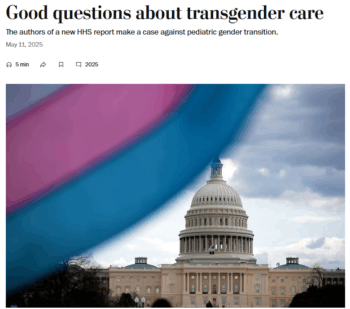If one company or small group of people manages to develop godlike digital superintelligence, they could take over the world. At least when there’s an evil dictator, that human is going to die. But for an AI, there would be no death. It would live forever. And then you’d have an immortal dictator from which we can never escape.
—Elon Musk
The Deep State is not going away. It’s just being replaced.
Replaced not by a charismatic autocrat or even a shadowy bureaucracy, but by artificial intelligence (AI)—unfeeling, unaccountable, and immortal.
As we stand on the brink of a new technological order, the machinery of power is quietly shifting into the hands of algorithms.
Under Donald Trump’s watch, that shift is being locked in for at least a generation.
 Trump’s latest legislative initiative—a 10-year ban on AI regulation buried within the “One Big Beautiful Bill”—strips state and local governments of the ability to impose any guardrails on artificial intelligence until 2035.
Trump’s latest legislative initiative—a 10-year ban on AI regulation buried within the “One Big Beautiful Bill”—strips state and local governments of the ability to impose any guardrails on artificial intelligence until 2035.
Despite bipartisan warnings from 40 state attorneys general, the bill passed the House and awaits Senate approval. It is nothing less than a federal green light for AI to operate without oversight in every sphere of life, from law enforcement and employment to healthcare, education, and digital surveillance.
This is not innovation.
This is institutionalized automation of tyranny.
This is how, within a state of algorithmic governance, code quickly replaces constitutional law as the mechanism for control.
We are rapidly moving from a society ruled by laws and due process to one ruled by software.
Algorithmic governance refers to the use of machine learning and automated decision-making systems to carry out functions once reserved for human beings: policing, welfare eligibility, immigration vetting, job recruitment, credit scoring, and judicial risk assessments.
In this regime, the law is no longer interpreted. It is executed. Automatically. Mechanically. Without room for appeal, discretion, or human mercy.
These AI systems rely on historical data—data riddled with systemic bias and human error—to make predictions and trigger decisions. Predictive policing algorithms tell officers where to patrol and whom to stop. Facial recognition technology flags “suspects” based on photos scraped from social media. Risk assessment software assigns threat scores to citizens with no explanation, no oversight, and no redress.
These algorithms operate in black boxes, shielded by trade secrets and protected by national security exemptions. The public cannot inspect them. Courts cannot challenge them. Citizens cannot escape them.
The result? A population sorted, scored, and surveilled by machinery.
This is the practical result of the Trump administration’s deregulation agenda: AI systems given carte blanche to surveil, categorize, and criminalize the public without transparency or recourse.
And these aren’t theoretical dangers—they’re already happening.
Examples of unchecked AI and predictive policing show that precrime is already here.
Once you are scored and flagged by a machine, the outcome can be life-altering—as it was for Michael Williams, a 65-year-old man who spent nearly a year in jail for a crime he didn’t commit. Williams was behind the wheel when a passing car fired at his vehicle, killing his 25-year-old passenger, who had hitched a ride.
Despite no motive, no weapon, and no eyewitnesses, police charged Williams based on an AI-powered gunshot detection program called ShotSpotter. The system picked up a loud bang near the area and triangulated it to Williams’ vehicle. The charge was ultimately dropped for lack of evidence.
This is precrime in action. A prediction, not proof. An algorithm, not an eyewitness.
Programs like ShotSpotter are notorious for misclassifying noises like fireworks and construction as gunfire. Employees have even manually altered data to fit police narratives. And yet these systems are being combined with predictive policing software to generate risk maps, target individuals, and justify surveillance—all without transparency or accountability.
It doesn’t stop there.
AI is now flagging families for potential child neglect based on predictive models that pull data from Medicaid, mental health, jail, and housing records. These models disproportionately target poor and minority families. The algorithm assigns risk scores from 1 to 20. Families and their attorneys are never told what the scores are, or that they were used.
Imagine losing your child to the foster system because a secret algorithm said you might be a risk.
This is how AI redefines guilt.
The Trump administration’s approach to AI regulation reveals a deeper plan to deregulate democracy itself.
Rather than curbing these abuses, the Trump administration is accelerating them.
An executive order titled “Removing Barriers to American Leadership in Artificial Intelligence,” signed by President Trump in early 2025, revoked prior AI safeguards, eliminated bias audits, and instructed agencies to prioritize “innovation” over ethics. The order encourages every federal agency to adopt AI quickly, especially in areas like policing and surveillance.
Under the guise of “efficiency,” constitutional protections are being erased.
Trump’s 10-year moratorium on AI regulation is the logical next step. It dismantles the last line of defense—state-level resistance—and ensures a uniform national policy of algorithmic dominance.
The result is a system in which government no longer governs. It processes.
The federal government’s AI expansion is building a surveillance state that no human authority can restrain.
Welcome to Surveillance State 2.0, the Immortal Machine.
Over 1700 uses of AI have already been reported across federal agencies, with hundreds directly impacting safety and rights. Many agencies, including the Departments of Homeland Security, Veterans Affairs, and Health and Human Services, are deploying AI for decision-making without public input or oversight.
This is what the technocrats call an “algocracy”—rule by algorithm.
In an algocracy, unelected developers and corporate contractors hold more power over your life than elected officials.
Your health, freedom, mobility, and privacy are subject to automated scoring systems you can’t see and can’t appeal.
And unlike even the most entrenched human dictators, these systems do not die. They do not forget. They are not swayed by mercy or reason. They do not stand for re-election.
They persist.
When AI governs by prediction, due process disappears in a haze of machine logic.
The most chilling effect of this digital regime is the death of due process.
What court can you appeal to when an algorithm has labeled you a danger? What lawyer can cross-examine a predictive model? What jury can weigh the reasoning of a neural net trained on flawed data?
You are guilty because the machine says so. And the machine is never wrong.
When due process dissolves into data processing, the burden of proof flips. The presumption of innocence evaporates. Citizens are forced to prove they are not threats, not risks, not enemies.
And most of the time, they don’t even know they’ve been flagged.
This erosion of due process is not just a legal failure—it is a philosophical one, reducing individuals to data points in systems that no longer recognize their humanity.
Writer and visionary Rod Serling warned of this very outcome more than half a century ago: a world where technology, masquerading as progress under the guise of order and logic, becomes the instrument of tyranny.
That future is no longer fiction. What Serling imagined is now reality.
The time to resist is now, before freedom becomes obsolete.
To those who call the shots in the halls of government, “we the people” are merely the means to an end.
“We the people”—who think, who reason, who take a stand, who resist, who demand to be treated with dignity and care, who believe in freedom and justice for all—have become obsolete, undervalued citizens of a totalitarian state that, in the words of Serling, “has patterned itself after every dictator who has ever planted the ripping imprint of a boot on the pages of history since the beginning of time. It has refinements, technological advances, and a more sophisticated approach to the destruction of human freedom.”
In this sense, we are all Romney Wordsworth, the condemned man in Serling’s Twilight Zone episode “The Obsolete Man.”
“The Obsolete Man,” a story arc about the erasure of individual worth by a mechanized state, underscores the danger of rendering humans irrelevant in a system of cold automation and speaks to the dangers of a government that views people as expendable once they have outgrown their usefulness to the State. Yet—and here’s the kicker—this is where the government through its monstrous inhumanity also becomes obsolete.
As Serling noted in his original script for “The Obsolete Man,” “Any state, any entity, any ideology which fails to recognize the worth, the dignity, the rights of Man…that state is obsolete.”
Like Serling’s totalitarian state, our future will be defined by whether we conform to a dehumanizing machine order—or fight back before the immortal dictator becomes absolute.
We now face a fork in the road: resist the rise of the immortal dictator or submit to the reign of the machine.
This is not a battle against technology, but a battle against the unchecked, unregulated, and undemocratic use of technology to control people.
We must demand algorithmic transparency, data ownership rights, and legal recourse against automated decisions. We need a Digital Bill of Rights that guarantees:
- The right to know how algorithms affect us.
- The right to challenge and appeal automated decisions.
- The right to privacy and data security.
- The right to be free from automated surveillance and predictive policing.
- The right to be forgotten.
Otherwise, AI becomes the ultimate enforcer of a surveillance state from which there is no escape.
As Eric Schmidt, former CEO of Google, warned: “We know where you are. We know where you’ve been. We can more or less know what you’re thinking about. Your digital identity will live forever… because there’s no delete button.”
An immortal dictator, indeed.
Let us be clear: the threat is not just to our privacy, but to democracy itself.
As I point out in my book Battlefield America: The War on the American People and in its fictional counterpart The Erik Blair Diaries, the time to fight back is now—before the code becomes law, and freedom becomes a memory.
The post
How AI and the Deep State Are Digitizing Tyranny first appeared on
Dissident Voice.
This post was originally published on Dissident Voice.








